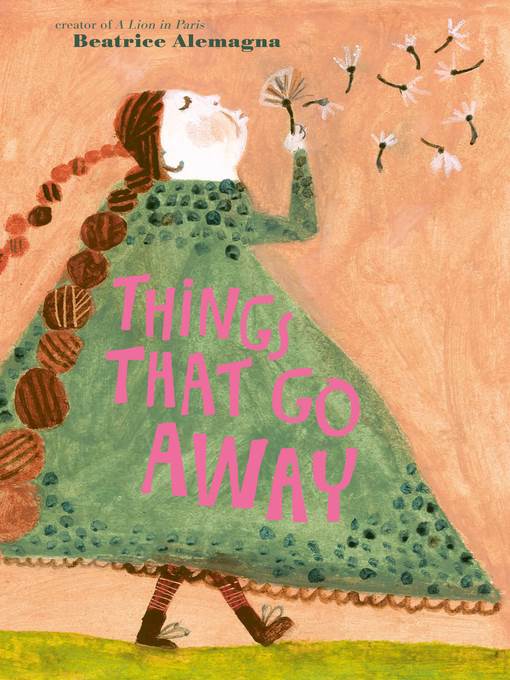
Things That Go Away
کتاب های مرتبط
- اطلاعات
- نقد و بررسی
- دیدگاه کاربران
نقد و بررسی

Starred review from December 16, 2019
This simple, beautiful creation by Alemagna (Child of Glass) does what it says on the tin: looks at transience. “In life, many things go away. They transform,” Alemagna starts. Each spread uses a page of translucent vellum to show something that’s there atop a background—and then, just as suddenly, gone. Here, a bird appears on the vellum in black ink, perched on someone’s outstretched finger; a page turn makes it disappear. Music, soap bubbles, tears, lice, autumn leaves—all there, and then gone. Against Alemagna’s expressive signature paintings, lyrical lines of verse, gracefully rendered by an uncredited translator, use tangible disappearance as a metaphor for unseen emotion: “Bad weather goes away” (the vellum shows streams of raindrops) “and so does fear” (a monster spreads its batlike wings over a frightened girl). A final page finds something that doesn’t disappear with the turn of a page: “But one thing doesn’t go away, and never will,” attends a spread of a parent embracing a child. A readaloud that introduces a rich field of big questions. Ages 4–8.

Starred review from February 1, 2020
PreS-Gr 3-Impermanence is the subject of this French import, and although its theme will resonate with adults, three elements ground it firmly in the realm of children's literature. First, children are genuinely curious or worried about the types of things undergoing transformation: the body falling asleep and waking, hair and teeth loss, wounded skin. Next, the book is designed with a transparent page inserted into each double spread; on it, black strokes outline hair, bubbles, steam, etc. In turning this page, the reader moves the objects, participating in the metamorphosis, as, for example, when a girl's closed eyelids lift to reveal her open eyes before they descend on her stuffed animal-or when a woman's disappearing tresses turn into a man's mustache. In these clever changes, there is humor or poignancy and acknowledgment of the span of life experiences. Bad weather "goes away," as does fear, depicted as a wolf hovering over a child in bed. Finally, the oil paintings are brimming with color and personality. Paired with minimal text, they invite conversations that go beyond the surface: The image accompanying "Dark thoughts fade..." shows a man sculpting, and as a mass of black shapes moves from his head to complete another sculpture on the verso, one can contemplate the role of art in supporting mental health. In an utterly reassuring conclusion featuring an embrace, readers learn that "...one thing never goes away, and never will." VERDICT This wise, creative book will be returned to with anticipation and shared frequently.-Wendy Lukehart, District of Columbia Public Library
Copyright 2020 School Library Journal, LLC Used with permission.

December 1, 2019
An exploration of things that are temporary. "In life, / many things go away. / They transform, / they pass by." Each double-page spread holds a special sheet, attached in the gutter, that's halfway between transparent and translucent. This sheet overlays first the right-hand page, then the left; it features black markings (different on every spread) that shift meaning as it turns. In one fine example, to demonstrate that "sleep always departs," heavily drawn, closed eyelids move from overlaying a child's face to a stuffed animal's. Unfortunately, many spreads are less successful. All the primary illustrations pale significantly when viewed through the middle sheet while the sheet's black drawings are particularly bold; consequently, flipping the sheet leftward often fails to hide or repurpose the black marks. Musical notes seemingly meant to disappear into a plant ("Music flies away") are so dark--and the underlying illustration so paled by the flip-over sheet--that the notes don't visually integrate into the plant but hover nonsensically. Tears drop from a child's eyes, but instead of blending into a cat's fur when the sheet flips, they sit confusingly overlaid on the cat. The conceit's weak implementation leaves little room for attention to Alemagna's heavy oil paintings with faces styled like children's art, nor to the otherwise lovely catalog of things that are (or can be) fleeting: injury, bubbles, bad moods, hair placement, steam from a teacup. A good idea philosophically and artistically--but tanked by weak execution. (Picture book. 4-7)
COPYRIGHT(2019) Kirkus Reviews, ALL RIGHTS RESERVED.

January 1, 2020
Grades K-2 Renowned author-illustrator Alemagna turns her artful ingenuity to the concept of impermanence in this wistful picture book. In life, many things go away. They transform, they pass by. She addresses both the physical and intangible: sleep departs, small wounds vanish, music flies away, and soap bubbles too. Every example gets a full spread, each of which is divided by a piece of tracing paper with a single, black design. When the reader turns the tracing paper from right to left, the image transforms in accordance with the text. A girl's tears appear to dry up as the drops shift seamlessly into the fur of a nearby cat. One person's parted mop of hair falls off to become her friend's drooping mustache. It's a clever gimmick that is sure to capture readers, especially young artists, though it distracts from?and, unfortunately, obscures?the wonderfully naive oil paintings. Ultimately, it concludes, one thing never goes away. Thankfully, Alemagna isn't so heavy-handed as to name that thing; much better to show a mother and child embracing.(Reprinted with permission of Booklist, copyright 2020, American Library Association.)

























دیدگاه کاربران